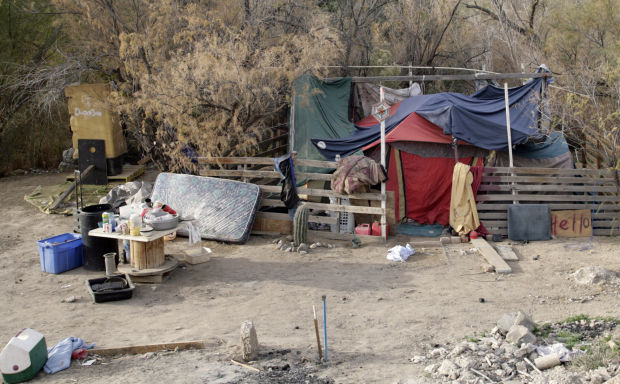The homeless population in Tucson has declined by about 600 people since 2012, based on results from this year’s Homeless Street Count.
But advocates say the count understates the need for stable housing here.
The annual Street Count event took place in January, when more than 300 volunteers combed the streets to find and interview homeless people in parks, washes and under bridges. The count, which incorporates data from local groups serving the homeless, includes unsheltered people living in places not meant for human habitation, and those who are temporarily sheltered in emergency or transitional housing.
The 2016 count identified 381 unsheltered people and 1,384 sheltered, for a total of 1,765. That’s compared to 2,366 in 2012.
People are also reading…
The figures are used to help local agencies better understand who is experiencing homelessness and help with plans to address unmet housing needs. It also provides the U.S. Department of Housing and Urban Development with a snapshot of homelessness here.
But it’s not a comprehensive count, especially for youth and families, said Claudia Powell, during a Friday presentation on the Street Count results. She is a research scientist at the University of Arizona.
Families who are homeless sometimes hide their children for fear of losing custody, she said. Families who live in their cars, or have unstable arrangements on couches, are less easy to spot than people living in homeless camps, she said.
Homelessness is a big problem in Tucson, but it is a solvable one, Tom Litwicki, chairman of the Tucson Pima Collaboration to End Homelessness, said at the Friday presentation.
“We’re still dealing with numbers that are manageable,” he said. “This is something that’s possible, that we can do.”
The count found the number of homeless veterans, sheltered and unsheltered, is 281. That figure has stayed steady for the past three years, but as Tucson has focused on ending veteran homelessness, 883 veterans have been housed since January 2015.
Homeless people who were interviewed during the count reported a number of risk factors for their health and safety: More than 330 were victims of domestic violence, 479 had serious mental illness, 460 reported a substance abuse disorder and 90 had HIV or AIDS.
The Tucson Pima Collaboration to End Homelessness aims to make the best use of about $8 million in HUD funding for the homeless that comes to the area annually, advocates said.
Last year Tucson had vacancy rates ranging from 17 to 24 percent in transitional and permanent housing. A coordinated entry system that prioritizes veterans and the chronically homeless will help address that issue, Litwicki said.
HUD is shifting its priorities from funding transitional housing programs to permanent housing and that shift was reflected in HUD’s grant awards announced this year, Litwicki said.
Research shows permanent housing is more cost-effective, and has the same or better success rates as transitional. But the change means there will be a gap in services for some families relying on transitional housing.











